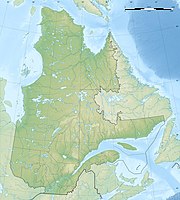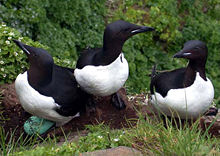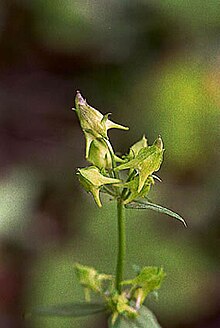Réserve écologique de la Pointe-Heath
|
Réserve écologique de la Pointe-Heath
|
||
| location | Minganie , Quebec, Canada | |
| surface | 18.69 km² | |
| WDPA ID | 23095 | |
| Geographical location | 49 ° 6 ′ N , 61 ° 44 ′ W | |
|
|
||
| Setup date | 1978 | |
| administration | MDDEP | |
The Réserve écologique de la Pointe-Heath is an ecological reserve in the eastern part of the Canadian province of Québec .
It was established in 1978 on an area of 1869 hectares. It is located in the regional county municipality of Minganie on the eastern edge of the island of Anticosti and includes its moorland. These are rain bogs , also called ombrotrophic bogs or raised bogs, as well as minerotrophic fens . Is also protected Falaise aux Goélands , a cliff, nesting in many birds, such as the thick-billed murre ( Uria lomvia ; French Guillemot de Brünnich or Marmette de Brünnich ), the puffin ( Fratercula arctica ), the kittiwake , which is a largest colony of Quebec forms, or the northern gannet ( Morus bassanus ), of which more than 200 pairs nest on the coast.
The protected area rises from the coast to a maximum height of 15 m above sea level and is extremely flat. The subsoil consists of sedimentary rocks, especially lime-rich deposits. The boundaries between the immediate bank area and the raised, fossil-rich plateau area above are sharply demarcated. It is covered by a thin layer of tillit that was formed during the last ice age. The organic deposits cause the two predominant types of peatland.
The predominant plants in the upland moors with no inflow are peat mosses (´ French sphaignes ), peat grapes and black spruce . As you get closer to the sea, the black crowberry increases. Where there are bodies of water with nutrients, there is less peat moss, instead sour grasses and sweet grasses predominate.
Where there are trees, it is mostly balsam firs or white spruces , usually as crooked wood .
176 vascular plants, 22 mosses, 9 lichens and 3 liverworts are recorded . At least two species are considered endangered or threatened: Halenia deflexa ssp. brentoniana and Gentianopsis nesophila , which belong to the gentian family ( Gentianaceae ).
The white-tailed deer , which is very numerous on the island, frequently visits the sanctuary, ducks can also be found here, and the Canada goose . Be found on the coast Black Guillemot ( Cepphus grylle , French guillemot à miroir ), and the Razorbill , the here Petit Pingouin is.
Web links
- Réserve écologique de la Pointe-Heath , government website


